Magic & Reality With Emma Thompson
Saturday, October 11, 2008
Some of my most enjoyable pleasures in coming to Lillooet are the routines of watching a movie the evening we arrive and breakfast the next day. A slight modification to this routine is Rebecca's Nintendo DS. I asked her what the DS meant and it is double screen as the game has two. I have re-baptized the game the DSB and when Rebecca asked me I told her, "It stands for dumb sh.. box." She was not amused. Breakfast of apple strudel, sausages, watermelon, melon and my own very strong tea had to be shared with a Rebecca telling the little dogs of her game to sit, beg and roll over.
Selecting a film at Videomatica is simple. Since I have to please Lauren, Rebecca, Rosemary and Ale my selection has to have a little bit of everything. I have found that the best place to look is in the British film section. We watched Nanny McFhee (2006), Directed by Kirk Jones; written by Emma Thompson and based on the Nurse Matilda books by Christianna Brand. Both Colin Firth and Emma Thompson star in it with a too brief but hilarious performance as an assistant embalmer by Derik Jacobi.
Rosemary and I discussed how this is the sort of film that satisifes everybody because the English, unlike Hollywood, do not dumb down. Rebecca just said, "Colin Firth is a heartthrob." I look forward to tonight's viewing of The Flight Of The Red Balloon. Can any film with Juliette Binoche be anything but luscious?
The picture here I took almost 50 years ago in the thieves' market of La Lagunilla in Mexico City. The man represents to me that blend of magic and reality which has to be the principal ingredient of why we were all glued to the screen last night.
W.H. Hudson In Reverse
Friday, October 10, 2008
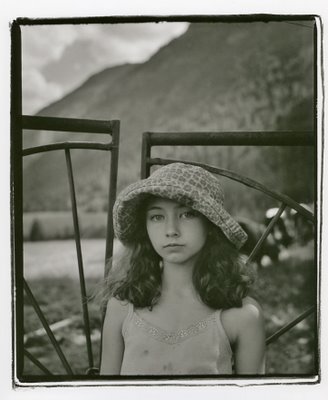
Rosemary is in a tizzy, as always, before we go anywhere. I have been instructed to make the pizza and choose what I want to wear. We are going with the girls, Lauren and Rebecca to visit Ale in Lillooet. The pizza is part of the routine that the girls like. We eat the pizza as soon as we are past Chilliwack on our way to Lillooet via the Fraser Canyon. For the trip I have to select 6 or 7 CDs of music. I mix jazz and classical piano to keep Rebecca's interest in that instrument alive. Today we will be listening to Philip Glass playing Metamorphoses on solo piano, and Philippe Entremont playing Satie's Piano Works. But there will also be some Dave Brubeck and John Lewis playing the piano with Bill Perkins (tenor sax), Jim Hall (guitar), Percy Heath (bass) and Chico Hamilton (drums) in one of my desert island discs 2 Degrees East - 3 Degrees West.
I always feel an excitement of going to the "country" or "the camp" as Anglo Argentines are fond of saying. As a little boy I was often dispatched by my parents to the campo for a few weeks during the summer school holidays in January. I marveled at the exhiliaration I felt when I stood on the Argentine pampa and I rotated my body 360 degrees and not find anything or anybody breaking that sharp horizon line unless it were that natural interruption of that non tree tree that Argentines worship, the Ombú.
This morning I gave it some extra thought and I had this curious feeling that somehow it was familiar but in reverse. I soon found the passage in William Henry Hudson's A Traveller in Little Things. This book of essays on travels throughout Britain were written four years after his autobiographical memoir, Far Away and Long Ago which gives an account of his childhood on the pampa where he was born in 1841. If he had written nothing else, Hudson would be remembered for this poignant memoir. There is a little bit of this memoir feeling in the little story The Two White Houses: A Memory.
It was the great southern road which leads from the city of Buenos Ayres, the Argentine capital, to the vast level cattle-country of the pampas, where I was born and bred. Naturally it was a tremendously exciting adventure to a child's mind to come from these immense open plains, where one lived in rude surrounding with the semi barbarous gauchos for only neighbours, to a great civilised town full of people and of things strange and beautiful to see. And to touch and taste.
Thus it happened that when I, a child, with my brothers and sisters, were taken to visit the town we would become more and more excited as we approached it at the end of a long journey, which usually took us two days, at all we saw - ox-carts and carriages and men on horseback on the wide hot dusty road, and the houses and groves and gardens on either side...
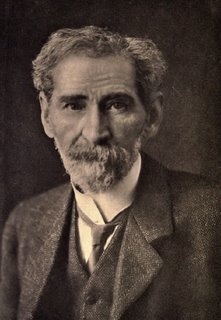
The estancia Hudson, Los 25 Ombues in Quilmes, Province of Buenos Aires where Hudson was born in, near the Chichitas river in Province of Buenos Aires, Argentina would be about 40 minutes away by train today. Quilmes then was certainly not Lillooet today nor does Vancouver today in any way resemble the lazy city of Buenos Aires then. But I still feel that my "journey into the interior" in a modern car with a slice of pizza on my lap is some sort of wonderful trip into the unknown.
I do look forward to it.
Of My Blog & Fading & Renewing Friendship
Thursday, October 09, 2008
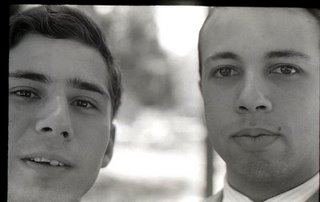 I have written of friendship and the loss of it here but it has been much in my thoughts of late. In that previous blog I quoted Harold Bloom from his book How To Read And Why: "We read not only because we cannot know enough people, but because friendship is so vulnerable, so likely to diminish or disappear, overcome by space,time, imperfect sympathies, and all the sorrows of familial and passional life."Last night I read something most similar from Julian Barnes's nothing to be frightened of: "I look around at my many friendships, and can recognize that some of them are not so much friendships any more as memories of friendship."Not too many months ago I finally was able to communicate with my cousing Georgito O'Reilly in Buenos Aires using Skype and a webcam. After a few minutes of conversation, Georgito, who has never ever not said what he thinks told me, "Here we are talking and yet we seem to have so little in common to talk about." I attempted to call a friend in the US with Skype but was stopped by the firewall of an answering machine that accepted no anonymous calls. Skype by its very nature is anoymous when one calls from computer to telephone. So I called up my friend on the regular phone and I was told he hated the phone but I could try his cellular. On another day I didi just that but I was cut off very quickly by, "Alex I am at my mother-in-law's and she hates for me to be on the phone, besides I don't really need to talk to you because I read your blog. I know what you are up to." Today I spoke with a local friend on the phone and began to tell him of my experience of reading the Julian Barnes book but I was interrupted, "I know all about it, I read it in your blog." My first cousin, Jorge Wenceslao de Irureta Goyena was my favourite cousin when I was a small boy principally because he was the only one I saw regularly. I lost him for a few years and saw him again when we were both 21. You can see us here (and further down when we were younger playing with his father's U-control airplanes) in a photo taken by simply extending my Pentacon F clunker camera in front with the self-timer in operation. It is in hazy focus but you can see the difference between us. he had inherited the dark good looks of his Argentine mother whose family hailed from the province of Corrientes. At the time of this photograph Wenci and I had a deep disagreement on Piazzolla and tango. According to Wenci Piazzolla was not tango. He was the conservative one while I argued that the tango had to evolve into something new. Somehow my memory does not tell me much as to why we didn't see much of each other. 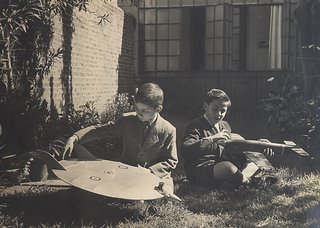 From his father, Antonio, who lived in North Carolina I found out quite a few years ago that Wenci had gone to meet up with him there. Then there was nothing and my uncle died. There were rumours (most shocking to Wenci's conservative family) that he had married a black woman with children. I did not know if this was true. With the advent of internet and Googgle I have been trying to tie up the loose strings of my life and I have located just about all the people that have meant something to me. In some cases I caught up with their trail a few months after their death and with others just in time. But the one I simply found nothing on was Wenci. Many of my friends and relatives did what most do as soon as they get internet. They Google themselves. Many found my blog and found me when I could not find them. Wenci was the holdout. I even managed to find his stepmother in North Carolina who told me that he had gone back to Buenos Aires after having lived in North Carolina for 19 years. It was a week or two ago that Wenci finally bought a computer and he did the obvious and he found me from a blog this one one about death! So we are back communicating with email and Skype phone calls. Pictures have been flying back and forth and I wonder when I or he will feel like Georgito O'Reilly that we might just have so little in common? In the other photo taken about the same time as the one with Wenci (also with a self timer but with the camera leaning on something) I am with my first real sweetheart, Corina. In recent years I hear little from her. She lives in England and has two boys. I sometimes prod her into answering. 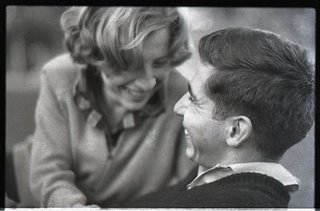 While surfing my blog my cousin Diane Hayward found this one. She was amazed as she had known Corina in school. Diane was older but they had gone to the same school. My cousin Elizabeth Blew and Corina had been classmates. Just a few days before finding my blog Diane and Elizabeth had run into Corina at a play. Corina had returned to BA for a few days to arrange the selling of a property. My name had no reason to be mentioned. But it was later. In fact Corina took singing lessons with Diane's mother my Aunt Iris. I guess I am the culprit that in my brief relationship with Corina I never mentioned the names of my cousins.
The Squirrels Had nothing to be frightened of
Wednesday, October 08, 2008
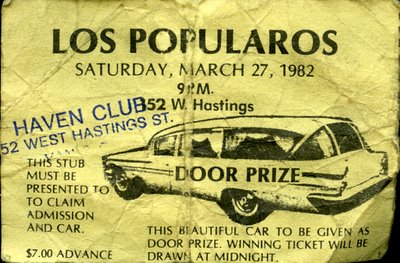 In 1949 Ilived in the Buenos Aires suburb of Coghlan on Calle Melián which was not far from the Pirovano Hospital. Beautiful black-lacquered hearses, drawn by four shiny black stallions with black plumes on their head, frequently passed by, empty, on their way to the hospital morgue. Because our street, like many then, and even now, were paved with large Paris style cobblestones we could always hear the precise clicking of the horse's hooves. We lingered in the hope of spotting the coffin behind the beveled crystal windows. Not long after I searched our garden plum trees for the appropriate horqueta or "y joint" that I could cut off to make an honda or slingshot. We always used a discarded bicycle inner tube to make the elastic part of the weapon. I then attempted to shoot any unlucky wren silly enough to rest in one of the plum trees. A few did and eventually I had my first kill. I was appalled and almost ashamed when I saw the dead bird on the grass. It was really my first look at death. I remember connecting with the character that Molly Parker (as a young girl) plays in the 1999 Lynne Stopkewich film Kissed. In it she buries dead animals from her garden with lots of pomp and ceremony in blue Birks boxes. I never shot at a bird again with that slingshot. Two years later, in 1951, my cousin Jorge Wenceslao de Irureta Goyena spotted a very large toad in an estancia north of Goya in the Province of Corrientes. He began to hit it with a large stone. I tried to stop him but to no avail. A few days later my uncle Tony (Wency's father) took us into the jungle with his .22 rifle. The jungle canopy was a loud green cloud of thousands of parakeets. We stopped and then Uncle Tony began a systematic execution of the birds telling us they were a plague. After 50 or 60 of them plummeted from the upper branches of the trees we went back to the estancia house. On July 26, 1952 Eva Perón died. I saw darkish b+w newsreels in the movies of the capilla ardiente a word that means a fired chapel but is simply a hocus pocus name for a place where a body lies in state with lots of candles and military guards. The music was Beethoven, Chopin and Lalo and there were many closeups of grieving descamisados (Peronist shirtless ones as Perón called his followers). Eva Perón was my first taste or awareness of human death. I was 9. Every evening when I was put to bed my mother turned on the radio. It did not matter what station it was as the program was always interrupted at 20:25. "It is 20:26," an Orson Welles voice boomed, "the hour when Eva Perón, the spiritual leader of our nation gained immortality." In the fall of 1966 my Armenian uncle Leo Mahdjoubian phoned. He didn't pull any punches. He simply told me, "Your father kicked the bucket yesterday and you should know." My father had died (DOA at the Pirovano Hospital) with enough money in his pocket that I was able to pay for a modest funeral. It was the first time in my life (once again for my mother) that I went shopping for a coffin. There was enough money left over to pay for a 7 year residence in Chacarita the large Buenos Aires cemetery where the masses are buried. On March 27, 1982 I purchased a ticket (number 175) to go to an underground concert with my favourite alternative band, the Popularos (below, with Art Bergmann middle row, right). It was my lucky night because I won the white Pontiac hearse. The organizers gave me the choice of the car or $500. I took the money. I put $250 in the bank and then bought $250 worth of beer (that was lots back on 1982) and invited all my alternative musician friends to a party. The beer was put into a bath tub. By the end of the night Zippy Pinhead (second row, left) was carried away and I was able to confirm there was still beer left in the tub. 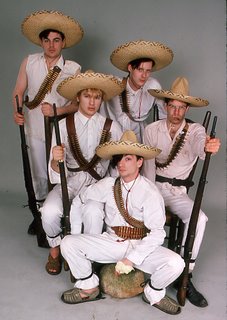 Sometime around 1989 I bought an air gun at Three Vets. It was a beautiful immitation .44 magnum which came with two barrels, a short one and a long one. In 1989 I was an eager but mostly ignorant gardener and I thought our garden squirrels were out to eat all our spring bulbs (I was partly right). I made the decision that I would shoot the varmints (that fine word the Americans like to use). But I decided I was going to give the little animals a spoorting chance by not wearing my glasses. I would quietly but suddenly open the kitchen door and then raise my gun. I would aim and shoot. I managed to get one. I saw it leap up when I shot it and it disappeared in a hosta bed. I went out searching and found the little animal agonizing but still alive. The animal was suddenly that wren from so long ago in my Buenos Aires garden. I gave the squirrel its coup de grâce and retired the gun on a table in the living room. When Hilary (not yet Rebecca or Lauren's mother) found out she told me that if I attempted to shoot any more squirrels she was going to call the SPCA. A few weeks later we had a burglar who stole my stereo, my CDs and the gun. When I made my insurance claim I kept the offending gun from the list. In 1989 I returned to Argentina for the first time since 1967. I visited my half brother Enrique and my nephews. One in particular, Patricio (affectionately nicknamed Pato or Duck) was especially interested in all things George as they all call my father and their grandfather. Patricio asked me about Chacarita and I told him that George's tomb would not be there anymore as they would have dug it up after 7 years and thrown its contents into a mass grave or filled some hole with its rubble. He looked at me with disgust. I forgot about it. A couple of days later Patricio came up to me and threw a little square marble stone on the table. He almost hit me with it. "I looked at the records to find where George was buried and located a Juana Esmeralda. She took George's place. I found this white pebble. Perhaps it had some contact with his bones."  Death has been in my thoughts of late here here and here. I have been at it for years because of my exposure to philosopher and teacher Ramón Xirau who taught me about Epicurus of Samos in 1964. For years I have avoided reading the books of British author Julian Barnes simply because he has a startling resemblance to a friend of mine, Michael Metcalf (seen below to the right of his father Ben) who committed suicide with a drug overdose. But I had to finally rescind my own prohibition and last night I began his latest nothing to be frightened of (Random House Canada 2008). Barnes describes his father's death: 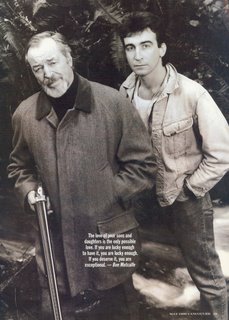 He died a modern death, in hospital, without his family, attended in his final minutes by a nurse, months - indeed, years - after medical science had prolonged his life to a point where the terms on which it was was being offered were unimpressive. My mother had seen him a few days previously, but then suffered an attack of shingles. On that final visit, he had been confused. She had asked him, characteristically, 'Do you know who I am? Because the last time I was here, you didn't know what I was.' My father had replied, just as characteristically,'I think you are my wife.' He died a modern death, in hospital, without his family, attended in his final minutes by a nurse, months - indeed, years - after medical science had prolonged his life to a point where the terms on which it was was being offered were unimpressive. My mother had seen him a few days previously, but then suffered an attack of shingles. On that final visit, he had been confused. She had asked him, characteristically, 'Do you know who I am? Because the last time I was here, you didn't know what I was.' My father had replied, just as characteristically,'I think you are my wife.'In the New York Times review of Barnes's book Garrison Keillor states: I don't know how this book will do in our hopeful country, with the author's bleak face on the cover, but I will say a prayer for retail success. It is a beautiful and funny book, still booming in my head. 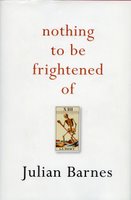 I am happy to report that so far I agree and furthermore I would like to add that the Canadian edition of nothing to be frightened of does not have Julian Barnes's bleak face on the cover.
John Loengard Teaches A Brat A Thing Or Two
Tuesday, October 07, 2008
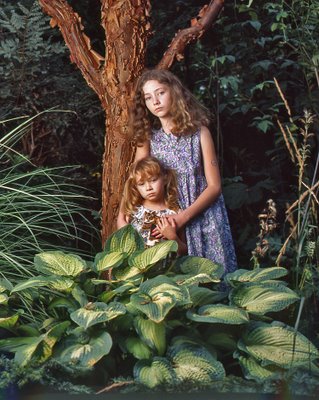 "I don't want people to know that I am a brat even if I am one." "I don't want people to know that I am a brat even if I am one."That is what Rebecca told me today when I mentioned that I would write in today's blog what a holy terror she had been when I tried to take her pictures alone and with Lauren in our fall garden on Sunday. Initially I had told Hilary Stewart (their mother) that I wanted the girls to show up on Sunday with appropriate dresses for the session. I had mentioned to Hilary that I was planning on taking pictures of them by the rich brownish red bark of Acer griseum (Paperbark Maple) and my large but collapsing Hosta 'Paul's Glory'. The girls appeared minus dresses so I sent Rosemary to get something for them from Hilary's. Immediately Rebecca informed me she was not going to wear a dress and said she was going to wear my mother's Mexican red rebozo. I pointed out that the red would kill the colour of the tree bark. She reluctantly put on the dress while repeating to me "I hate this dress. I hate all dresses." When I showed her the location for the photo she told me it was cold and she was not going to go barefoot into that wet and dirty ground. I told her to wear shoes. She then complained about the spiders (she had never been afraid of them until Sunday) and flatly refused to pose by the tree until I told her she had to, "Donde manda capitán no manda marinero," or Where the captain orders the sailor obeys. By the time she and the extremely cooperative Lauren were by the tree Rebecca was shouting at Lauren to not step on her or for this or that. Rebecca would cry and then suddenly microseconds later she would hum a tune. I could never get anything but a glum, disgusted or bored look from her. It became worse when I put her in the middle of my rose bed (see yesterday's blog) where she now complained she was going to get scratched by rose thorns. "This is the last picture, "she would tell me. Or she asked, "How many more?" I was reluctant to answer as my inspiration to take pictures was rapidly drying out. But we did take a few and in spite of it all I like some of our photos. But certainly not as much as the glamorous picture I took of her three years ago in my studio.  Perhaps it was all worth it because of the startling but charming statement she made about being a brat. I told her I was going to write about it all and showed her the page, page 58 from Lohn Loengard's Pictures Under Discussion. I told her to read what Loengard had written about his daughter Jennifer Loengard (1983) which was the name of the beautiful picture (below, left in b+w). I think I might just try a regal profile of Rebecca with b+w film soon. She read it and understood and complained no further. I have a feeling that our next photo session might just be more pleasant. And here are Loengard's words on his daughter Jennifer: If I take a picture of my daughter, our relationship changes and she is not my daughter any more. She could just as easily be the Duchess of Malfi. If she says, "Oh, Dad, not now!" I'll treat her exactly as I woud Georgia O'Keeffe if she said, "Oh, Mr Loengard, please not now!" In my head I think, "There is a beautiful picture here and by God, short of murder, I'm going to get it. So shut up and hold still!" But what I say is : "You look wonderful. I'll just take a minute. It's marvelous. We're doing something very special."
I learned the part about a minute from a dentist. I learned the rest from Carl Mydans. For the magazine's thirtieth birthday, Life photographers were asked to photograph each other. Carl was assigned to me. To see such an intelligent and distinguished man concentrating on the problem of taking my picture was extremely flattering. Still I felt tense. After all I was being scrutinized. Carl kept telling me what wonderful pictures were being made. I believed him, and soon I relaxed. I was a success at being a subject!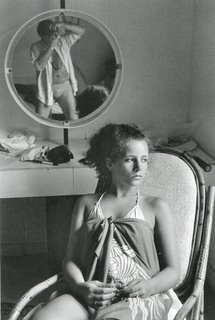 (You should tell these things to a person as you photograph him - even if it is a lie - which in this case it was. Life photographers as it turned out, could photograph anything in the world except each other.) (You should tell these things to a person as you photograph him - even if it is a lie - which in this case it was. Life photographers as it turned out, could photograph anything in the world except each other.)
John Loengard Puts Up
Monday, October 06, 2008

I think that tomorrow's blog, like today will feature pictures of my granddaughters and something on photographer John Loengard. John Loengard ( 1934) was both photographer and picture editor for Life Magazine during the height of its influence on the world of photography. Alas except for a few people who might know, Loengard is not a household name even though he does have a web presence. These days photographers that may interest those under 30 seem to all be called Chip. John would then not be good enough.
What separates Loengard from many other photographers is his beautiful writing when he explains his photographs. The black and white photograph you see here is his daughter Anna and the picture is called Anna, 1975. It is from his wonderful book Pictures Under Discussion (A Bob Adelman book - Amphoto an imprint of Watson-Guptill Publicatioons New York 1987)which I treasure in my photography book library. I will hope that Mr. Leongard does not send lawyers after me for quoting from page 110:
 Dinner table conversation about photography changes from year to year, so that what is on everyone's mind now is different from 1973. That was the year I started teaching, when Diane Arbus's work was having its first success and photographic galleries were springing up from nowhere. At the time I wondered if all photography would become not only self-expressive but self-conscious as well. It didn't. Photographers may be concerned, conceptual, confrontational, candid, casual, constructing, but what is important is that they have a point of view.
Dinner table conversation about photography changes from year to year, so that what is on everyone's mind now is different from 1973. That was the year I started teaching, when Diane Arbus's work was having its first success and photographic galleries were springing up from nowhere. At the time I wondered if all photography would become not only self-expressive but self-conscious as well. It didn't. Photographers may be concerned, conceptual, confrontational, candid, casual, constructing, but what is important is that they have a point of view.
When I teach a class I often give the assignment: "Photograph someone you love." I ask people to do this so they have a subject about whom they have feelings, a subject that is more than a model, or an object or a shape, or an idea. In this way, they can judge the result not only by its technical success, but also by how well it describes their feelings. Having asked some students to do this in 1975, I thought it was time to put up or shut up. I took on the assignment too, and asked my younger daughter, Anna, to pose quietly in the afternoon light against the dining room-room door, which she did with enthusiasm. She's never been lovelier.
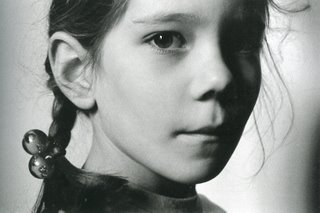
Loengard writes above, "...which she did with enthusiasm." This is something that Rebecca did not show on Sunday afternoon when I took these pictures. But then if you want to know about it read right here, tomorrow.
Cyril Belshaw & The Wondrous Chinese Spoon
Sunday, October 05, 2008
Chinese soup spoon, in japanese "fallen lotus petal" — usually ceramic and of a distinct Chinese soup spoon shape, which can vary in size from normal soup spoon size to near-platter size.
In 1950 when I was 8 years old my mother took me to the house of one of her Chinese students at the American School in Buenos Aires. For someone who had only seen white people and the accasional darkish Bolivian or Argentine aboriginal this was as exciting as things got. Unfortunately I was also an Argentine meat, potato and salad kind of boy and the prospect of being offered exotic food was downright scary. And scary it was. I did a lot of drinking of water to wash down food of uncertain origin. But I was fascinated by my first glimpse of the lovely Chinese spoon. I have been delighted and fascinated by it since. The design of the spoon would blend in with anything from Bauhaus.
Sometime in the early 80s I was dispatched by Vancouver Magazine to photograph UBC Professor of Anthropology, Cyril Belshaw. Through his friend Don Stanley, associate editor at Vancouver Magazine, Belshaw had granted Vancouver Magazine an exclusive interview right after he had been found innocent in European courts of murdering his wife.
I decided before I got to Belshaw's house (I had been forewarned not to disclose his address to anybody) that I was going to photogrpah his face and hands separately and leave it up to the Vancouver Magazine readers to decide if indeed he was a murderer or not. But when I got there and he opened the door I was met by a quiet spoken man with a tragic expression on his face. He was visibly nervous about the approaching ordeal of being photographed. "Don't tell anybody I live here. If they find out they will stop and point in this direction and say, ""He lives there.""
I had to find a way of making him feel comfortable as this has always been my course of action. He had agreed to be photographed so it was up to me to help him even though I had an ulterior motive up my sleeve in reference to his hands.
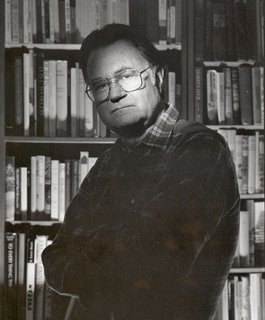
To help him relax I decided to ask him a question to which I had never received a satisfactory answer. "Sir, why is it that the Japanese adopted many of the customs of the Chinese, and went as far as copying their writing, and using the Chinese chop sticks, yet they never copied or used the Chinese spoon? We do know that the Japanese slurp their liquids and the spoon they finally adopted was the Western spoon." Belshaw's answer was a simple one but a startling one, "Cultures have always been known to selectively adopt and adapt only what interests them from other cultures. They, the Japanese were not interested in the spoon so they did not use it."
After this explanation I sensed a release and determination and Belshaw faced my camera. I quickly turned off the light that was pointed at his hands and took my portrait. I felt that the lighting of his hands would have overstepped my duty of being as objective as possible. If a court had found the man innocent I had no right to editorialize and cast any suspicion.
|

























